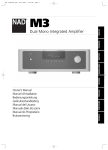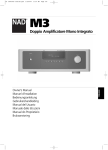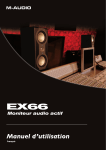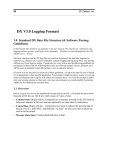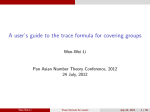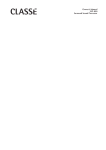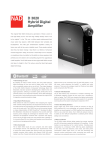Download NAD M3 audio amplifier
Transcript
The Masters Series – M3 Dual Mono Integrated Amplifier ANALOG SOUND, DIGITAL CONTROL - 180 watts X 2, 10Hz – 20kHz, with <0.03% THD, both channels driven into 8 or 4 Ohms The M3 is NAD’s concept of the ideal musical companion, capable of transporting the listener to that place where the music simply exists in its own perfect space. For this task we have pushed classical analog circuit design to unprecedented levels of performance. The total lack of audible noise and distortion is the result of some very sophisticated analog engineering, and rather surprisingly, the use of digital control. - Dynamic power of 280 watts at 8 Ohms, 480 watts at 4 Ohms, and 785 watts at 2 Ohms - PowerDrive™ - Dual stage high current/high voltage power supply Freed of the constraints of traditional analog switches, NAD’s Director of Advanced Development, Bjorn Erik Edvardsen devised an architecture using precision 1% resistors controlled by digital switches for all the level adjustments required for volume control, balance control and tone control. (Yes we still believe in tone controls – more on that later.) Input selection is via precision sealed reed relays. A major advantage of this architecture, in addition to its extremely precise performance, is the ability to place controls in the most advantageous physical position within the circuit. The signal never has to travel to the front panel for switching, as with traditional amplifier designs. Getting to the infinitesimal levels of noise and distortion of the M3 requires very careful circuit layout, as only tiny changes in the signal path can have large effects on performance. Keeping signal paths as short as possible is also greatly aided by the use of SMD (miniature surface mount) components and multi-layer PCBs (circuit boards). - Dual Mono topology - Twin NAD Custom-Made “Holmgren” Toroidal transformer - Ultra precise multi-stage electronic volume control using discreet resistors - 7 inputs, including 1 balanced XLR - Tape/Zone 2 output (independent source selection, no volume control) - Speakers A + B with custom 5 way binding posts - Biamp mode with selectable 40, 60, 80, 100 Hz crossover frequency on Pre Out 1 - Powered subwoofer LUXURIOUS STYLING AND INTELLIGENT CONTROL - Main Amp input The design brief reads: “The industrial design must create a physical presence that is powerful, dynamic, and solid, yet refined and elegant”. We wanted a design that will still look fresh and new a decade from now, a design with classic proportions and understated details. We also wanted an amplifier that was not only easy to operate, but also very flexible and complete in its control options. - Remote Bass and Treble controls with Spectral Tilt option - Remote Balance control with 0.5 dB steps - Selectable Mono, Left, Right, and Stereo options - RS-232 interface for advanced custom installations - 12V Trigger for advanced control options, 1 Out - 3.5mm IR Control jacks, 1 In and 2 Out - Detachable AC cord - M3 System Remote Control - ZR 3 second zone remote Unlike many high performance amplifiers, the M3 includes a full suite of convenience features. Speaker switching for two pairs of speakers and very flexible tone controls are provided, as is a Zone 2 output with its own independent set of commands and dedicated ZR 3 remote control. Front panel controls use a multi-function knob and buttons to quickly navigate all amplifier functions. All operating conditions are clearly displayed on a 2 line dot matrix VFD display. Direct access is available to many functions via the SRM 3 remote handset. The SRM 3 handset also features basic controls for the matching NAD DVD/SACD player. Performance features include a multi-stage precision volume attenuator with 0.5dB steps and a range of 87.5dB, a remote balance control with 0.5dB steps, and a Mode control that allows stereo, left only, right only, and mono settings. Tone controls offer bass and treble adjustment, as well as a ‘spectral tilt’ option that is highly effective at correcting the tonal balance of many recordings by simultaneously increasing the bass and decreasing the treble (and vice versa) to create a warmer (or cooler) balance. We have also included a second set of preamp outputs and a switchable high pass filter for the internal amplifier, to allow easy implementation of an active subwoofer or biamplification. The rugged chassis is built using thick 2mm mild steel plates with a front panel employing extruded aluminum and die-cast zinc in its construction. Special attention was paid to the control of mechanical resonance, as this can affect sonic performance. Special isolation feet use aluminum and silicon rubber in a vibration damping configuration. All signal connectors are heavy duty gold Biamp function allows the use of a second amplifier or active subwoofer PreOut 2, and offers a high pass filter function on PreOut 1, with selectable 40Hz, 60Hz, 80Hz, 100Hz or Full Range options. These are analog 2nd order filters configured around the low impedance differential Class A output stage of the preamp. This output stage also employs proprietary distortion cancellation circuitry. A balanced line input is also provided using identical JFET buffers feeding a discrete differential amp and yielding common mode rejection in excess of 80dB. Separately regulated DC supplies are derived from the dual mono power supply. Copper buss bars and discrete regulators keep circuit noise to an absolute minimum throughout. The display and digital functions operate from an independent power supply to prevent any interference with the analog signal path. POWER AMP HIGHLIGHTS The M3 features a Dual Mono design with separate unregulated, and discrete regulated supplies for different stages of the 2 channels. The twin custom-made “Holmgren” toroidal transformers use proprietary magnetic shielding technology. High current rectifiers feed low ESR 105C filter capacitors. plated types specifically engineered for the NAD Masters Series components. Finished inside and out, the M3 utilizes powder coating and advanced automotive paint finishes, creating an enduring and elegant mechanical package. PREAMP DESIGN The preamp uses all discrete low noise high impedance JFET buffer amps and very high quality reed relay switches at the preamp input. Special high current low output impedance Class A gain modules provide tremendous dynamic headroom and high output current, combined with a exceptional S/N ratio in excess of -100dB (IHF). The volume attenuator is very unique in that it uses discrete 1% precision resistors that keep impedance (and noise) very low. It is arrayed in 3 stages to reduce the residual noise in each amplifying stage and prevent the ‘cascade effect’ of noise that is present in most preamp designs. This circuit also provides the balance control, and as a result channel separation is superb and inter-channel cross talk is virtually eliminated. These resistor arrays are switched using 15 volt digital switches under software control, keeping all attenuation at the ideal point in the circuit architecture. Low impedance stepped tone controls provide +/- 5 db of boost/cut in the bass and treble regions, or can be configured to provide variable slope, or ‘spectrum tilt’ at +/3dB per decade. NAD’s PowerDrive technology measures load impedance continuously on each channel and adjusts the power supply voltage for maximum undistorted dynamic power into the connected speaker at all times and under all operating conditions. The signal processor also continuously measures temperature and average long term power and, based on this information, chooses the optimum voltage. PowerDrive allows the M3 to sound far more powerful than its already impressive 180 watt per channel rating would suggest. Totally effortless sound, even at elevated levels, is the hallmark of the PowerDrive amplifier. The M3 utilizes a wideband current-mode Class A voltage amp featuring large open loop compensated bandwidth, and running from low noise stabilised power supplies. NAD’s patented current amp output stage starts with < 0.02 % static and dynamic distortion open loop (before feedback), even into 3 ohms at 20-20k at all levels. By utilizing small amounts of feedback the circuit returns distortion levels at all audible frequencies that are at limit of measurement – less than 0.002%! The super rugged output stage features 4 pairs of 150W discrete bipolar output transistors per channel, for 50A peak undistorted output current. Massive heat sinking assures a lifetime of trouble free operation. Preliminary Specifications Pre-Amp Section Line level inputs Input impedance (R+C) Balanced Input impedance (R+C) Input sensitivity, rated power Frequency response (-3dB - 70kHz)* 150k//500p 120k//100p 446mV <+/-0.3dB Line level outputs Output impedance Tape Signal/noise ratio 10 Source Z + 1k ohm >110dB (AWTD) Tone Controls Bass Treble Spectral Tilt ±5dB ±5dB ±3dB Power Amp Section Continuous output power into 4/8 ohms † Rated Distortion (THD 20Hz - 20kHz) Clipping power ‡ IHF dynamic headroom at 8 ohms IHF dynamic power at 8 ohms IHF dynamic power at 4 ohms IHF dynamic power at 2 ohms Damping factor (ref. 8 ohms, 50Hz) Input impedance Input Sensitivity (for rated power into 8 ohms) Voltage gain Frequency response; 20Hz-20kHz -3dB at: Signal/noise ratio; ref 1W Signal/noise ratio; ref rated power 2 x 180W (22.5dBW) 0.004% 220W (23.4dbW) 4.2dB 280W (24.5dBW) 480W (27.2dBW) 785W (28.4dBW) >150 20k ohm/ 680pF 1.38V 29dB +/-0.03dB >80kHz >107dB (AWTD) >130dB Physical Specifications Dimensions (W x H x D) Net Weight Shipping Weight 17 1/8 x 5 1/4 x 15 3/16” (435 x 135 x 386mm) 51.8 lbs (23.5 kg) 67.0 lbs (30.5kg) NAD Electronics International reserves the right to change specifications or features without notice as design improvements are incorporated. NAD is a registered trademark of NAD Electronics Internat� written permission of NAD Electronics. International. Printed in Canada 05/05. www.NADelectronics.com




